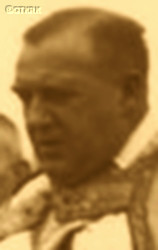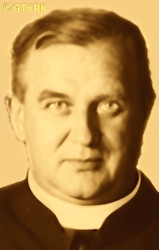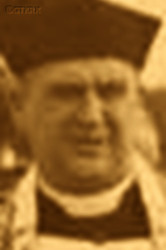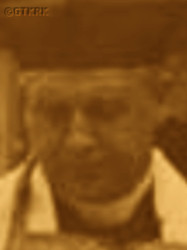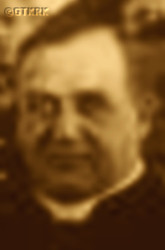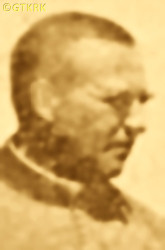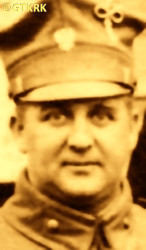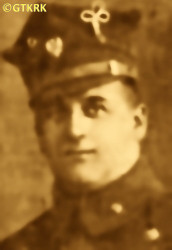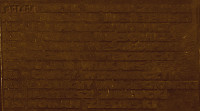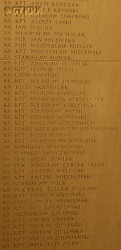Roman Catholic
St Sigismund parish
05-507 Słomczyn
85 Wiślana Str.
Konstancin deanery
Warsaw archdiocese, Poland
full list:
displayClick to display full list

searchClick to search full list by categories
wyświetlKliknij by wyświetlić pełną listę po polsku

szukajKliknij by przeszukać listę wg kategorii po polsku

Martyrology of the clergy — Poland
XX century (1914 – 1989)
personal data
surname
WILKANS
forename(s)
Julian
function
diocesan priest
creed
Latin (Roman Catholic) Church RCmore on
en.wikipedia.org
[access: 2014.09.21]
diocese / province
Gniezno and Poznań archdiocese (aeque principaliter)more on
www.archpoznan.pl
[access: 2012.11.23]
RC Military Ordinariate of Polandmore on
en.wikipedia.org
[access: 2014.12.20]
honorary titles
Papal chamberlainmore on
Papal chamberlain
(22.06.1926)
„Polonia Restituta” Cross — 4th Class, Officer'smore on
„Polonia Restituta” Cross – 4th_Class, Officer's
(11.11.1937)
„Cross of Valour”more on
„Cross of Valour”
„Medal of Independence”more on
„Medal of Independence”
(16.03.1933)
Ten Years of Independence Medalmore on
Ten Years of Independence Medal
Commemorative Medal for War of 1918–21more on
Commemorative Medal for War of 1918-21
Gold „Cross of Merit”more on
Gold „Cross of Merit”
(18.01.1926)
„Cross of Valour”more on
„Cross of Valour”
(13.04.1921)
date and place
of death
05.12.1942

KL Dachauconcentration camp
today: Dachau, Upper Bavaria reg., Bavaria state, Germany
more on
en.wikipedia.org
[access: 2016.05.30]
details of death
After the outbreak of World War I, drafted into the German Imperial Empire. Throughout the war, from 02.08.1914 to 10.11.1918, was the chaplain of the German army garrison in Inowrocław. Inowrocław was the place of formation of the Germ. 4. Westpreussisches Infanterie Regiment Nr. 140 (Eng. 4th West Prussian Infantry Regiment No. 140) and the Germ. Hinterpommersches Feldartillerie–Regiment Nr. 53 (Eng. Farther Pomerania Field Artillery Regiment No. 53), which were part of the Germ. 4. Infanterie–Division (Eng. 4th Infantry Division) — during the war they fought in, among others, on the Western Front. Their reserve/spare units were stationed in Inowrocław. The city was also a place of concentration for other units before heading to the front.
In 07.1918, in Inowrocław, as well as in other cities of the Germ. Provinz Posen (Eng. Province of Poznań), or Greater Poland, a clandestine Inter‐Party Committee was established, also known as the Citizens' Committee TMKO, as a representation of the Central Citizens' Committee CKO in Poznań. CKO recognized the Polish National Committee operating in Paris as the legal authorities of Poland, which was de facto an act of treason against the German state. Actively cooperated with it. After the abdication on 09.11.1918 of the German Emperor William II Hohenzollern; after the signing on 11.11.1918 by the Allies and the Germans, in the staff wagon in Compiègne, at the headquarters of French Marshal Ferdinand Foch, of the armistice and ceasefire — which de facto meant the end of World War I; and also after the handover on 11.11.1918 by the Regency Council – operating in the so‐called Germ. Königreich Polen (Eng. Polish Kingdom) occupied by the Central Powers (Germany and Austria–Hungary) — of supreme command over the army to Brigadier Joseph Piłsudski and his appointment as Commander‐in‐Chief of the Polish Army, which de facto meant the rebirth of the Polish state, encompassing however only the Germ. Königreich Polen, i.e. the Polish territory under Russian rule until 1915, but excluding the lands of the Prussian partition; Greater Poland — as the Prussian Germ. Provinz Posen — was still formally part of the German state. In Inowrocław, on 10.11.1918, the Soldiers'–Workers'–Citizens' Council RŻRO was established, based on the model and inspired by a similar council established in Berlin. The soldiers' part was established in the garrison, to which soldiers returning from the front kept arriving, and where ministered. Immediately afterwards, the TMKO revealed itself, from c. 28.11.1918 adopting the name of the County People's Council PRL — Inowrocław was the seat of the Germ. Kreis Hohensalza (Eng. Inowrocław County) — modelled on the CKO from Poznań, which was transformed into the Supreme People's Council NRL. Became the representative of the TMKO (later the PRL) in the RŻRO and at the same time its liaison with the NRL. RŻRO, the majority of which were Poles, led to the introduction of Poles to the city authorities — until then they had no Polish representation — and then to end Germanization in schools, to the start of teaching of all subjects in Polish and recognition of German as just one of the remaining subjects. As a representative of the Council, initiated the creation of similar Polish authorities in the second city of the district, Kruszwica. Spoke at a rally there, „in the Polish spirit”, but no representative of the Polish community was elected the Soldiers' and Workers' Council established there.
The situation was getting worse, though. On 06.12.1918, a Germ. Volksrat (Eng. People's Council) was established in Inowrocław, purely German, of an anti‐Polish character. On 01.12.1918, the PRL agreed to form Polish units of the People's Guard, whose members were mainly representatives of the Clandestine Military Committee, consisting of younger generation Polish independence activists. On 27.12.1918, the Greater Poland Uprising broke out in Poznań. Few days later, on 01.01.1919, a hastily formed 100‐strong insurgent company set off from Gniezno, liberated on 29.12.1918. Without a fight, it occupied Trzemeszno, entered the already free Mogilno, and on 02‐03.01.1919, it liberated Kruszwica. In each of these places, the ranks of the insurgents swelled. When on 04.01.1919 reached Inowrocław numbered c. 500 people. The Poles took over the post office building, the railway station (however, it was retaken by the Germans) and attacked the military garrison and the 140th Infantry Regiment stationed there. The bloody battle lasted until the morning of 05.01.1919, with every street fought for. In the evening, local peasants appeared on the streets of the city — there were supposedly as many as 10,000 of them — and the Germans, practically surrounded in the railway station building and in the barracks, asked for a truce. Participated in talks between the German commandant and representatives of the Polish Council. On the night of 05‐06.01.1919, a ceasefire was concluded, providing for the Germans to leave the city with weapons in their hands.
Became then the chaplain of the 1st Greater Poland Rifle Regiment, formed by order of the General Command of the insurgent Greater Poland Army No. 14 of 19.01.1919, and sworn in on 26.01.1919, in Poznań.
The Regiment was stationed in Biedrusko base from 30.01.1919, where its formation was completed, and then, starting on 17.03.1919, it took part in the Polish–Ukrainian War of 1919‐1921, initially in the battles to unblock Lviv, which had been surrounded by Ukrainians (relief of Lviv), and ending on 19.05.1919 with the capture of Stryi.
After the Regiment returned to Poznań on 06.06.1919, and after the Treaty of Versailles concluded on 28.06.1919, which ended World War I and awarded Greater Poland to Poland, promoted on 01.07.1919 to the chaplain of the 1st Greater Poland Rifle Division of the Greater Poland Army, with the title of its pastor. This army (by the daily order of the Supreme Command of the Polish Army of 28.08.1919 incorporated into the Polish Army, although formally Germ. Provinz Posen, where it was stationed, was still part of the German state; formally it became part of Poland on 10.01.1920, after the ratification of the Treaty of Versailles by all parties) and his Division — renamed 14th Greater Poland Infantry Division on 10.12.1919 — took part in the Polish–Russian War of 1919‐1921. The Division was transported to the Lithuanian–Belarusian Front and on 08.08.1919 its units took part in the capture of Minsk, and then on 27.08.1919 of Bobruisk on the Berezina River. For the next 11 months it protected the front line established by the Polish army on the line of the Dvina and Berezina rivers, and along a number of lakes linking them in the north. The application for the award of the Cross of Valour included the following: „On 18.10.1919 during the action […] to expand the Bobruisk bridgehead, Fr Wilkans, being in the front line of battle, kept up the spirit of the soldiers […] Sometimes disregarding the rather heavy fire, strove to provide spiritual help to the dying soldier […] Showed admirable courage, serving as a good example to the soldier in very difficult moments. With courage and zealous work, always tried to raise the spirit of the soldier for a new fight, which earned him great trust among the soldiers”.
At the end of 1919, however, prob. returned to Greater Poland. On 01.01.1920, became chaplain of the Greater Poland Front, established on 01.11.1919 by the Polish Army in expectation of German attack — the Germans had gathered an army of c. 300,000 on the borders of Greater Poland. However, the attack did not materialise and on 10.01.1920 the Germans ratified the Treaty of Versailles, which awarded Greater Poland to Poland. On 23.03.1920, the Front was disbanded. Became than prob. chaplain of the 7th Reserve Infantry Brigade, formed from 02.1920 in the General District „Poznań”, which later became part of the Reserve Army. However, on 23.04.1920 became chaplain of the 3rd Army. From 25.04.1920 the Army took part in the so‐called Kiev expedition, a Polish preemptive attack on the Russians, who after the fall of the German Empire attacked Eastern Ukraine — which they themselves had previously recognized as an independent state in the Treaty of Brest‐Litovsk of 03.03.1918 between the Central Powers (Germany and Austria–Hungary) and Bolshevik Russia. Formally, the Army was commanded by General Rydz‐Śmigły, but in fact by Joseph Piłsudski himself. It reached and entered Kiev on 07.05.1920. From 27.05.1920, when the Russian offensive began, was in retreat. After breaking through the Russian encirclement on 10.06.1920, reached Korosten. Later, it withdrew to the vicinity of Ovruch, and at the end of 06.1920 beyond the Ubort River in Volyn. For some time at the beginning of 07.1920 it defended its position on the Styr River, after which in continuous clashes with the attacking Russians at the beginning of 08.1920 withdrew to the Lublin region. However, at that time — on 13.08.1920, a few days before the decisive battle and the Polish triumph in the Battle of Warsaw (known as the „Miracle on the Vistula”) — prob. withdrawn from the front and appointed dean of the entire General District „Poznań”.
In peacetime after 1920 was a chaplain of the Polish Army in active service. Decommissioned on 31.03.1939.
During the mobilization in 08.1939, joined the „Poznań” Army, and after the German and Russian invasion of the Republic of Poland in 09.1939 and the start of World War II, covered its entire combat route.
From 05.09.1939, due to the Germans' encirclement of Greater Poland region, marched with the Army east, towards Warsaw.
From 09.09.1939, took part in the largest battle of the 09.1939 Campaign, the Battle of Bzura, until the Polish defeat and dissolution of the Army on 21.09.1939.
Managed to get through to Warsaw, besieged by the Germans, and there ministered in one of the field hospitals.
Was in Warsaw on the day of the its capitulation on 28.09.1939 and the beginning of the German occupation.
Avoided arrest and managed to get back to his parish, Jarząbkowo.
There — or in the neighboring Niechanowo parish, which administered from 1940, after the Germans arrested its parish priest, Fr John Szlachta — arrested by the Germans on 01.10.1941.
Held in the KL Posen concentration camp (Fort VII).
Next on 10.10.1941 moved to the IL Long transit camp in Ląd.
Finally, on 30.10.1941 transported to KL Dachau concentration camp, where perished.
According to the death certificate, prepared in KL Dachau, the „honest” otherwise German „medical doctors” and formalists — and at the same time, unrivaled fairy tale spinners — noted that the cause of death Germ. „Versagen von Herz und Kreislauf, bei Bauchwassersucht” (Eng. „Heart and circulatory failure, due to abdominal dropsy”).
prisoner camp's numbers
28220Click to display source page (KL DachauClick to display the description)
cause of death
extermination: exhaustion and starvation
perpetrators
Germans
sites and events
KL DachauClick to display the description, IL LondClick to display the description, KL PosenClick to display the description, 06.10.1941 arrests (Warthegau)Click to display the description, Reichsgau WarthelandClick to display the description, Ribbentrop‐MolotovClick to display the description, Pius XI's encyclicalsClick to display the description, Polish‐Russian war of 1919‐1921Click to display the description, Polish‐Ukrainian war of 1918‐1919Click to display the description, Greater Poland UprisingClick to display the description
date and place
of birth
18.12.1886

Oćwiekatoday: Gąsawa gm., Żnin pov., Kuyavia‐Pomerania voiv., Poland
more on
en.wikipedia.org
[access: 2021.12.18]
parents
WILKANS Theodore
🞲 ?, ? — 🕆 ?, ?

NICHE Anne
🞲 ?, ? — 🕆 ?, ?
presbyter (holy orders)
ordination
30.01.1910

Poznańtoday: Poznań city pov., Greater Poland voiv., Poland
more on
en.wikipedia.org
[access: 2021.07.18]
St Peter and St Paul the Apostles RC archcathedral churchmore on
en.wikipedia.org
[access: 2025.03.14]
positions held
1939 – 1941
parish priest — Jarząbkowotoday: Niechanowo gm., Gniezno pov., Greater Poland voiv., Poland
more on
en.wikipedia.org
[access: 2022.08.05] ⋄ St Martin the Bishop and Confessor RC parish ⋄ Wrześniatoday: Września gm., Września pov., Greater Poland voiv., Poland
more on
en.wikipedia.org
[access: 2021.06.20] RC deanery — prob. from c. 08.1939
1940 – 1941
administrator — Niechanowotoday: Niechanowo gm., Gniezno pov., Greater Poland voiv., Poland
more on
en.wikipedia.org
[access: 2021.07.18] ⋄ St James the Apostle RC parish ⋄ Wrześniatoday: Września gm., Września pov., Greater Poland voiv., Poland
more on
en.wikipedia.org
[access: 2021.06.20] RC deanery — acting („ad interim”)
13.08.1920 – 1939
RC military dean — Poznańtoday: Poznań city pov., Greater Poland voiv., Poland
more on
en.wikipedia.org
[access: 2021.07.18] ⋄ Command of the Corps District DOK No. VII Poznań, Polish Armed Forces — commissioned head of the District Roman Catholic Pastoral Ministry; by decree of the Chief of State of 03.05.1922, confirmed with seniority from 01.06.1919 and 9th place on the list of Roman Catholic military deans, in the rank of colonel; by L. 3448 decree of the Commander‐in‐Chief of 16.12.1921, verified with seniority from 01.04.1920 and 9th place on the list of Roman Catholic military deans, in the rank of colonel; decommissioned on 31.07.1939; also: in 1921 member of the Verification Commission for the Clergy of the Catholic Faith, established on 12.03.1921 by the L.2743 decree of the Commander‐in‐Chief, preparing a list of seniority and a proposal for the appointment of Catholic chaplains from former armies of partitioning powers, Polish Legions, Eastern Corps, General Haller's Army and chaplains of the Greek Catholic rite, to officer ranks
23.04.1920 – 13.08.1920
RC military chaplain — 3rd Army, Polish Armed Forces — titular dean
23.03.1920 – 23.04.1920
RC military chaplain — 7th reserve Infantry Brigade, Polish Armed Forces
01.01.1920 – 23.03.1920
RC military chaplain — Greater Poland Front, Polish Armed Forces — titular military dean; formally accepted into the Polish Army as a chaplain by L. 2238 decree of the Commander‐in‐Chief of 30.07.1920
01.07.1919 – 12.1919
RC military chaplain — 1st Greater Poland Rifle Division, Greater Poland Army (i.e. Polish Armed Forces in the former Prussian Partition), Polish Armed Forces — titular military pastor; on 10.12.1919 the Division renamed the 14th Greater Poland Infantry Division
26.01.1919 – 01.07.1919
RC military chaplain — 1st Greater Poland Rifle Regiment, Greater Poland Army (i.e. Polish Armed Forces in the former Prussian Partition), Polish Armed Forces — the Regiment formed by Chief‐Command No. 14 order of 19.01.1919; on 26.01.1919 sworn in and received the banner at Freedom Square in Poznań
c. 1919
vicar — Poznańtoday: Poznań city pov., Greater Poland voiv., Poland
more on
en.wikipedia.org
[access: 2021.07.18] ⋄ St Adalbert the Bishop and Martyr RC parish ⋄ Poznańtoday: Poznań city pov., Greater Poland voiv., Poland
more on
en.wikipedia.org
[access: 2021.07.18] RC deanery
1914 – 1918
RC military chaplain — Inowrocławtoday: Inowrocław gm., Inowrocław pov., Kuyavia‐Pomerania voiv., Poland
more on
en.wikipedia.org
[access: 2021.07.18] ⋄ garrison, German Imperial Army
1911 – 1919
vicar — Inowrocławtoday: Inowrocław gm., Inowrocław pov., Kuyavia‐Pomerania voiv., Poland
more on
en.wikipedia.org
[access: 2021.07.18] ⋄ St Nicholas the Bishop and Confessor RC parish (main parish) ⋄ Inowrocławtoday: Inowrocław gm., Inowrocław pov., Kuyavia‐Pomerania voiv., Poland
more on
en.wikipedia.org
[access: 2021.07.18] RC deanery
1910 – 1911
vicar — Gnieznotoday: Gniezno urban gm., Gniezno pov., Greater Poland voiv., Poland
more on
en.wikipedia.org
[access: 2021.12.18] ⋄ Holy Trinity RC parish (main parish) ⋄ Gniezno Holy Trinitydeanery name
today: Gniezno urban gm., Gniezno pov., Greater Poland voiv., Poland
more on
en.wikipedia.org
[access: 2021.12.18] RC deanery
till 1910
student — Gnieznotoday: Gniezno urban gm., Gniezno pov., Greater Poland voiv., Poland
more on
en.wikipedia.org
[access: 2021.12.18] ⋄ philosophy and theology, Archbishop's Practical Theological Seminary (Lat. Seminarium Clericorum Practicum)
from 1906
student — Poznańtoday: Poznań city pov., Greater Poland voiv., Poland
more on
en.wikipedia.org
[access: 2021.07.18] ⋄ philosophy and theology, Archbishop's Theological Seminary (Collegium Leoninum)
others related
in death
SZLACHTAClick to display biography John, DADACZYŃSKIClick to display biography Roman Joseph, GORGOLEWSKIClick to display biography Joseph, SMOLIŃSKIClick to display biography Joseph Tomislav Henry, TRZYBIŃSKIClick to display biography Valentine, WOJTYNIAKClick to display biography Ceslav
sites and events
descriptions
KL Dachau: KL Dachau in German Bavaria, set up in 1933, became the main German Germ. Konzentrationslager (Eng. concentration camp) KL for Catholic priests and religious during World War II: On c. 09.11.1940, Reichsführer‐SS Heinrich Himmler, head of the SS, Gestapo and German police, as a result of the Vatican's intervention, decided to transfer all clergymen detained in various concentration camps to KL Dachau camp. The first major transports took place on 08.12.1940. In KL Dachau Germans held approx. 3,000 priests, including 1,800 Poles. The priests were forced to slave labor in the Germ. „Die Plantage” — the largest herb garden in Europe, managed by the genocidal SS, consisting of many greenhouses, laboratory buildings and arable land, where experiments with new natural medicines were conducted — for many hours, without breaks, without protective clothing, no food. They slaved in construction, e.g. of camp's crematorium. In the barracks ruled hunger, freezing cold in the winter and suffocating heat during the summer, especially acute in 1941‐1942. Prisoners suffered from bouts of illnesses, including tuberculosis. Many were victims of murderous „medical experiments” — in 11.1942 c. 20 were given phlegmon injections; in 07.1942 to 05.1944 c. 120 were used by for malaria experiments. More than 750 Polish clerics where murdered by the Germans, some brought to TA Hartheim euthanasia centre set up in Schloss Hartheim in Austria and murdered in gas chambers. At its peak KL Dachau concentration camps’ system had nearly 100 slave labour sub‐camps located throughout southern Germany and Austria. There were c. 32,000 documented deaths at the camp, and thousands perished without a trace. C. 10,000 of the 30,000 inmates were found sick at the time of liberation, on 29.04.1945, by the USA troops… (more on: www.kz-gedenkstaette-dachau.deClick to attempt to display webpage
[access: 2013.08.10], en.wikipedia.orgClick to attempt to display webpage
[access: 2016.05.30])
IL Lond: The Gestapo District Office in Poznań issued on 13.12.1939 executive instruction Ref. IIB No. 406/39 Tgb. No. 3045/39, ordering: „Based on the regulation of the Germ. Höherer SS‐ und Polizeiführer (Eng. Higher Commander of the SS and Police) [of the German province of Warthegau (Eng. Greater Poland)] of 12.11.1939 [SS‐Gruppenführer Wilhelm Koppe], apart from Poles and Jews, also Catholic clergy will be expelled. Action against this group of people should be carried out in such a way that internment and transport are separate […] C. 80% of Catholic clergy are expected to be expelled. The selection based on political threat posed. Internees cannot be placed in regular transit camps due to the possibility of international protest. Catholic clergy should be interned in men's monasteries and held there till mass transportation out”. And so in 1940‐1941, in a formerly Cistercian priory and monastery (today Salesian Institute) in Ląd on Warta river Germans set‐up a transit Germ. „Internierungslager” (Eng. „Internment camp”) for Polish priests and religious, from Włocławek, Gniezno, Warszawa, Poznań, Płock and Częstochowa dioceses and religious and monks from a number of congregations. Approx. 152 religious (70 till 03.04.1941 and 82 in 06‐28.10.1941) were held there prior to being sent to KL Dachau concentration camp. After the deportation, the Germans organized a training center for the German National Socialist youth wing, Germ. „Hitler‐Jugend” (Eng. „Hitler youth”), in the abbey. (more on: pl.wikipedia.orgClick to attempt to display webpage
[access: 2013.08.10], yadda.icm.edu.plClick to attempt to display webpage
[access: 2016.03.14])
KL Posen: German Posen — Fort VII — camp founded in c. 10.10.1939 in Poznań till mid of 11.1939 operated formally as Germ. Konzentrationslager (Eng. concentration camp) KL Posen, and this term is used throughout the White Book, also later periods. It was first such a concentration camp set up by the Germans on Polish territory — in case of Greater Poland (Wielkopolska) directly incorporated into German Reich. In 10.1939 in KL Posen for the first time Germans used gas to murder civilian population, in particular patients of local psychiatric hospitals. From 11.1939 the camp operated as German political police Gestapo prison and transit camp (Germ. Übergangslager), prior to sending off to concentration camps, such as KL Dachau or KL Auschwitz. In 28.05.1941 the camp was rebranded as police jail and slave labour corrective camp (Germ. Arbeitserziehungslager). At its peak up to 7‐9 executions were carried in the camp per day, there were mass hangings of the prisoners and some of them were led out to be murdered elsewhere, outside of the camp. Altogether in KL Posen Germans exterminated approx. 20,000 inhabitants of Greater Poland (Wielkopolska) region, including many representatives of Polish intelligentsia, patients and staff of psychiatric hospitals and dozen or so Polish priests. Hundreds of priests were held there temporarily prior to transport to other concentration camps, mainly KL Dachau. From 03.1943 the camp had been transformed into an industrial complex (from 25.04.1944 — Telefunken factory manufacturing radios for submarines and aircrafts). (more on: www.wmn.poznan.plClick to attempt to display webpage
[access: 2019.02.02], en.wikipedia.orgClick to attempt to display webpage
[access: 2013.12.27])
06.10.1941 arrests (Warthegau): On 13.09.1941 Germ. Gauleiter (Eng. regional leader) of German province Germ. Reichsgau Wartheland (Eng. Wartheland Reich district), in German‐occupied Greater Poland (where German standard law was in force), Artur Greiser, implementing „Ohne Gott, ohne Religion, ohne Priesters und Sakramenten” — „without God, without religion, without priest and sacrament” — policy issued a decree formally dissolving Catholic Church and forming in its place a Roman Catholic German National Church in Germ. Warthegau, an organization subject to a German private law. The ordinance was issued backdated to 01.09.1939, i.e. the date of the German invasion of Poland, which sanctioned the later robbery of the property of the Catholic Church acting for the benefit of the Polish population by the Germans. All the contacts with Vatican were forbidden. All the religion congregations were also dissolved. Soon after, on 06‐07.10.1941, mass arrests of Polish Catholic priests took place — c. 352 were detained. All were herded into DL Konstantinow in Konstantynów or IL Lond in Ląd on Warta river transit camps or KL Posen concentration camp (in this case, the detainees were first registered, photographed and examined in the infamous Poznań headquarters of the German political police, the Gestapo, in the former Soldier's House). On 30.10.1941 most of them were transported to KL Dachau concentration camp.
Reichsgau Wartheland: After the Polish defeat in the 09.1939 campaign, which was the result of the Ribbentrop‐Molotov Pact and constituted the first stage of World War II, and the beginning of German occupation in part of Poland (in the other, eastern part of Poland, the Russian occupation began), the Germans divided the occupied Polish territory into five main regions (and a few smaller). The largest one was transformed into Germ. Generalgouvernement (Eng. General Governorate), intended exclusively for Poles and Jews and constituting part of the so‐called Germ. Großdeutschland (Eng. Greater Germany). Two were added to existing German provinces. From two other separate new provinces were created. Greater Poland region was one of them, incorporated into Germany on 08.10.1939, by decree of the German leader Adolf Hitler (formally came into force on 26.10.1939), and on 24.01.1940 transformed into the Germ. Reichsgau Wartheland province, in which the law of the German state was to apply. The main axis of the policy of the new province, the territory of which the Germans recognized as the Germ. „Ursprünglich Deutsche” (Eng. „natively German”), despite the fact that 90% of its inhabitants were Poles, was Germ. „Entpolonisierung” (Eng. „Depolonisation”), i.e. forced Germanization. C. 100,000 Poles were murdered as part of the Germ. „Intelligenzaktion”, i.e. extermination of Polish intelligentsia and ruling classes. C. 630,000 were forcibly resettled to the Germ. Generalgouvernement, and their place taken by the Germans brought from other areas occupied by Germany (e.g. the Baltic countries, Bessarabia, Bukovina, etc.). Poles were forced to sign the German nationality list, the Germ. Deutsche Volksliste DVL. As part of the policy of „Ohne Gott, ohne Religion, ohne Priesters und Sakramenten” (Eng. „No God, no religion, no priest or sacrament”) most Catholic priests were arrested and sent to concentration camps. All schools teaching in Polish, Polish libraries, theaters and museums were closed. Polish landed estates confiscated. To further reduce the number of the Polish population, Poles were sent to forced labor deep inside Germany, and the legal age of marriage for Poles was increased (25 for women, 28 for men). The German state office, Germ. Rasse‐ und Siedlungshauptamt (Eng. Main Office of Race and Settlement) RuSHA, under the majesty of German law, abducted several thousand children who met specific racial criteria from Polish families and subjected them to forced Germanization, handing them over to German families. After the end of hostilities of World War II, the overseer of this province, the Germ. Reichsstatthalter (Eng. Reich Governor) and the Germ. Gauleiter (Eng. district head) of the German National Socialist Party, Arthur Karl Greiser, was executed. (more on: en.wikipedia.orgClick to attempt to display webpage
[access: 2024.06.21])
Ribbentrop‐Molotov: Genocidal Russian‐German alliance pact between Russian leader Joseph Stalin and German leader Adolf Hitler signed on 23.08.1939 in Moscow by respective foreign ministers, Mr. Vyacheslav Molotov for Russia and Joachim von Ribbentrop for Germany. The pact sanctioned and was the direct cause of joint Russian and German invasion of Poland and the outbreak of the World War II in 09.1939. In a political sense, the pact was an attempt to restore the status quo ante before 1914, with one exception, namely the „commercial” exchange of the so‐called „Kingdom of Poland”, which in 1914 was part of the Russian Empire, fore Eastern Galicia (today's western Ukraine), in 1914 belonging to the Austro‐Hungarian Empire. Galicia, including Lviv, was to be taken over by the Russians, the „Kingdom of Poland” — under the name of the General Governorate — Germany. The resultant „war was one of the greatest calamities and dramas of humanity in history, for two atheistic and anti‐Christian ideologies — national and international socialism — rejected God and His fifth Decalogue commandment: Thou shall not kill!” (Abp Stanislav Gądecki, 01.09.2019). The decisions taken — backed up by the betrayal of the formal allies of Poland, France and Germany, which on 12.09.1939, at a joint conference in Abbeville, decided not to provide aid to attacked Poland and not to take military action against Germany (a clear breach of treaty obligations with Poland) — were on 28.09.1939 slightly altered and made more precise when a treaty on „German‐Russian boundaries and friendship” was agreed by the same murderous signatories. One of its findings was establishment of spheres of influence in Central and Eastern Europe and in consequence IV partition of Poland. In one of its secret annexes agreed, that: „the Signatories will not tolerate on its respective territories any Polish propaganda that affects the territory of the other Side. On their respective territories they will suppress all such propaganda and inform each other of the measures taken to accomplish it”. The agreements resulted in a series of meeting between two genocidal organization representing both sides — German Gestapo and Russian NKVD when coordination of efforts to exterminate Polish intelligentsia and Polish leading classes (in Germany called «Intelligenzaktion», in Russia took the form of Katyń massacres) where discussed. Resulted in deaths of hundreds of thousands of Polish intelligentsia, including thousands of priests presented here, and tens of millions of ordinary people,. The results of this Russian‐German pact lasted till 1989 and are still in evidence even today. (more on: en.wikipedia.orgClick to attempt to display webpage
[access: 2015.09.30])
Pius XI's encyclicals: Facing the creation of two totalitarian systems in Europe, which seemed to compete with each other, though there were more similarities than contradictions between them, Pope Pius XI issued in 03.1937 (within 5 days) two encyclicals. In the „Mit brennender Sorge” (Eng. „With Burning Concern”) published on 14.03.1938, condemned the national socialism prevailing in Germany. The Pope wrote: „Whoever, following the old Germanic‐pre‐Christian beliefs, puts various impersonal fate in the place of a personal God, denies the wisdom of God and Providence […], whoever exalts earthly values: race or nation, or state, or state system, representatives of state power or other fundamental values of human society, […] and makes them the highest standard of all values, including religious ones, and idolizes them, this one […] is far from true faith in God and from a worldview corresponding to such faith”. On 19.03.1937, published „Divini Redemptoris” (Eng. „Divine Redeemer”), in which criticized Russian communism, dialectical materialism and the class struggle theory. The Pope wrote: „Communism deprives man of freedom, and therefore the spiritual basis of all life norms. It deprives the human person of all his dignity and any moral support with which he could resist the onslaught of blind passions […] This is the new gospel that Bolshevik and godless communism preaches as a message of salvation and redemption of humanity”… Pius XI demanded that the established human law be subjected to the natural law of God , recommended the implementation of the ideal of a Christian state and society, and called on Catholics to resist. Two years later, National Socialist Germany and Communist Russia came together and started World War II. (more on: www.vatican.vaClick to attempt to display webpage
[access: 2023.05.28], www.vatican.vaClick to attempt to display webpage
[access: 2023.05.28])
Polish‐Russian war of 1919‐1921: War for independence of Poland and its borders. Poland regained independence in 1918 but had to fight for its borders with former imperial powers, in particular Russia. Russia planned to incite Bolshevik‐like revolutions in the Western Europe and thus invaded Poland. Russian invaders were defeated in 08.1920 in a battle called Warsaw battle („Vistula river miracle”, one of the 10 most important battles in history, according to some historians). Thanks to this victory Poland recaptured part of the lands lost during partitions of Poland in XVIII century, and Europe was saved from the genocidal Communism. (more on: en.wikipedia.orgClick to attempt to display webpage
[access: 2014.12.20])
Polish‐Ukrainian war of 1918‐1919: One of the wars for borders of the newly reborn Poland. At the end of 1918 on the former Austro‐Hungarian empire’s territory, based on the Ukrainian military units of the former Austro‐Hungarian army, Ukrainians waged war against Poland. In particular attempted to create foundation of an independent state and attacked Lviv. Thanks to heroic stance of Lviv inhabitants, in particular young generation of Poles — called since then Lviv eaglets — the city was recaptured by Poles and for a number of months successfully defended against furious Ukrainian attacks. In 1919 Poland — its newly created army — pushed Ukrainian forces far to the east and south, regaining control over its territory. (more on: en.wikipedia.orgClick to attempt to display webpage
[access: 2017.05.20])
Greater Poland Uprising: Military insurrection of Poles of former German Germ. Posen Provinz (Eng. Poznań province) launched against German Reich in 1918‐1919 — after the abdication on 09.11.1918 of the German Emperor William II Hohenzollern; after the armistice between the Allies and Germany signed on 11.1.1918 in the HQ wagon in Compiègne, the headquarters of Marshal of France Ferdinand Foch — which de facto meant the end of World War I — against the German Weimar Republic, established on the ruins of the German Empire, aiming to incorporate lands captured by Prussia during partitions of Poland in XVIII century into Poland. The Republic of Poland, reborn on 11.11.1918, initially formally included only the so‐called Germ. Königreich Polen (Eng. Kingdom of Poland), i.e. the territory that had been under Russian rule until 1915 and then under the control of Central States (Germany and Austria–Hungary), but did not include the Prussian partition. Started on 27.12.1918 in Poznań and ended on 16.02.1919 with the armistice pact in Trier, forced by the victorious Entente states, which included provisions ordering Germany to cease operations against Poland and, importantly, recognizing the Polish insurgent Greater Poland Army as an allied armed force of the Entente. De facto it turned out to be a Polish victory, confirmed in the main peace treaty after World War I, the Treaty of Versailles of 28.06.1919, which came into force on 10.01.1920 and in which most of the lands of the Prussian partition were recognized as Polish. Many Polish priests took part in the Uprising, both as chaplains of the insurgents units and members and leaders of the Polish agencies and councils set up in the areas covered by the Uprising. In 1939 after German invasion of Poland and start of the World War II those priests were particularly persecuted by the Germans and majority of them were murdered. (more on: en.wikipedia.orgClick to attempt to display webpage
[access: 2016.08.14])
sources
personal:
www.wtg-gniazdo.orgClick to attempt to display webpage
[access: 2012.11.23], www.archiwum.archidiecezja.plClick to attempt to display webpage
[access: 2013.08.10], pl.wikipedia.orgClick to attempt to display webpage
[access: 2015.09.30], www.ipgs.usClick to attempt to display webpage
[access: 2012.11.23], lbc.leszno.plClick to attempt to display webpage
[access: 2023.12.15], kpbc.umk.plClick to attempt to display webpage
[access: 2023.12.15], www.wbc.poznan.plClick to attempt to display webpage
[access: 2023.12.15]
bibliographical:
„Martyrology of the Polish Roman Catholic clergy under nazi occupation in 1939‐1945”, Victor Jacewicz, John Woś, vol. I‐V, Warsaw Theological Academy, 1977‐1981
„International Tracing Service (ITS), Bad Arolsen, GermanyClick to display source page”, Arolsen Archives
original images:
www.audiovis.nac.gov.plClick to attempt to display webpage
[access: 2013.08.10], www.audiovis.nac.gov.plClick to attempt to display webpage
[access: 2015.09.30], www.audiovis.nac.gov.plClick to attempt to display webpage
[access: 2015.09.30], audiovis.nac.gov.plClick to attempt to display webpage
[access: 2016.08.14], audiovis.nac.gov.plClick to attempt to display webpage
[access: 2016.08.14], www.wbc.poznan.plClick to attempt to display webpage
[access: 2023.12.15], www.facebook.comClick to attempt to display webpage
[access: 2021.12.19], www.wtg-gniazdo.orgClick to attempt to display webpage
[access: 2012.11.23], www.katedrapolowa.plClick to attempt to display webpage
[access: 2014.01.16]
LETTER to CUSTODIAN/ADMINISTRATOR
If you have an Email client on your communicator/computer — such as Mozilla Thunderbird, Windows Mail or Microsoft Outlook, described at WikipediaPatrz:
en.wikipedia.org, among others — try the link below, please:
LETTER to CUSTODIAN/ADMINISTRATORClick and try to call your own Email client
If however you do not run such a client or the above link is not active please send an email to the Custodian/Administrator using your account — in your customary email/correspondence engine — at the following address:

giving the following as the subject:
MARTYROLOGY: WILKANS Julian
To return to the biography press below:
 Click to return to biography
Click to return to biography








